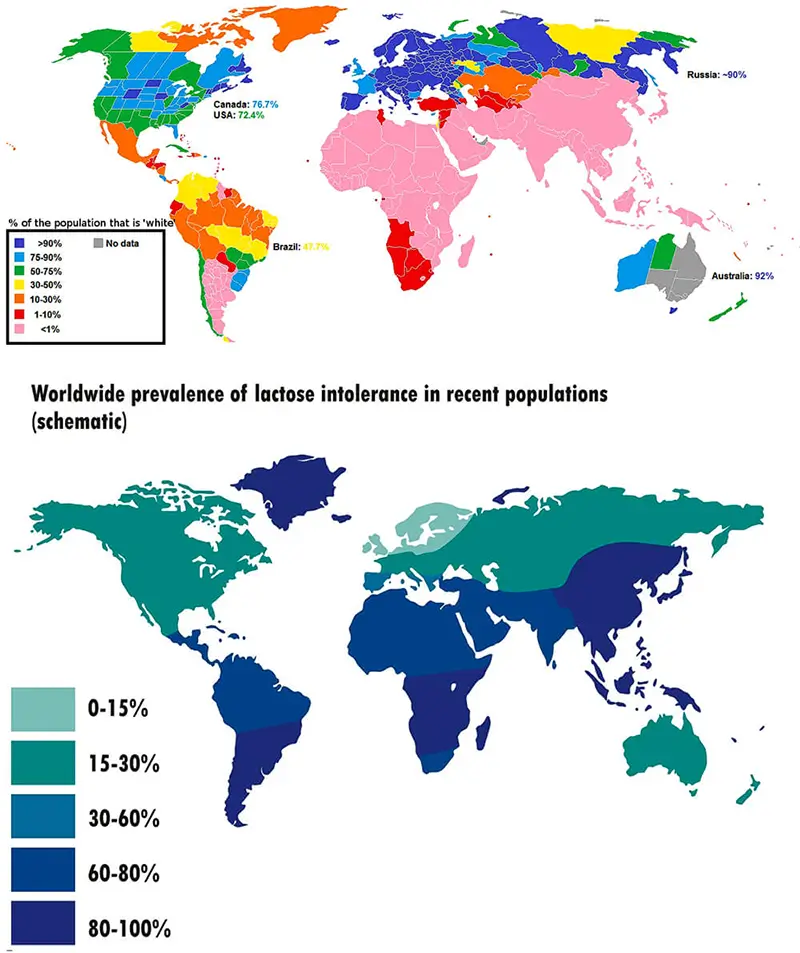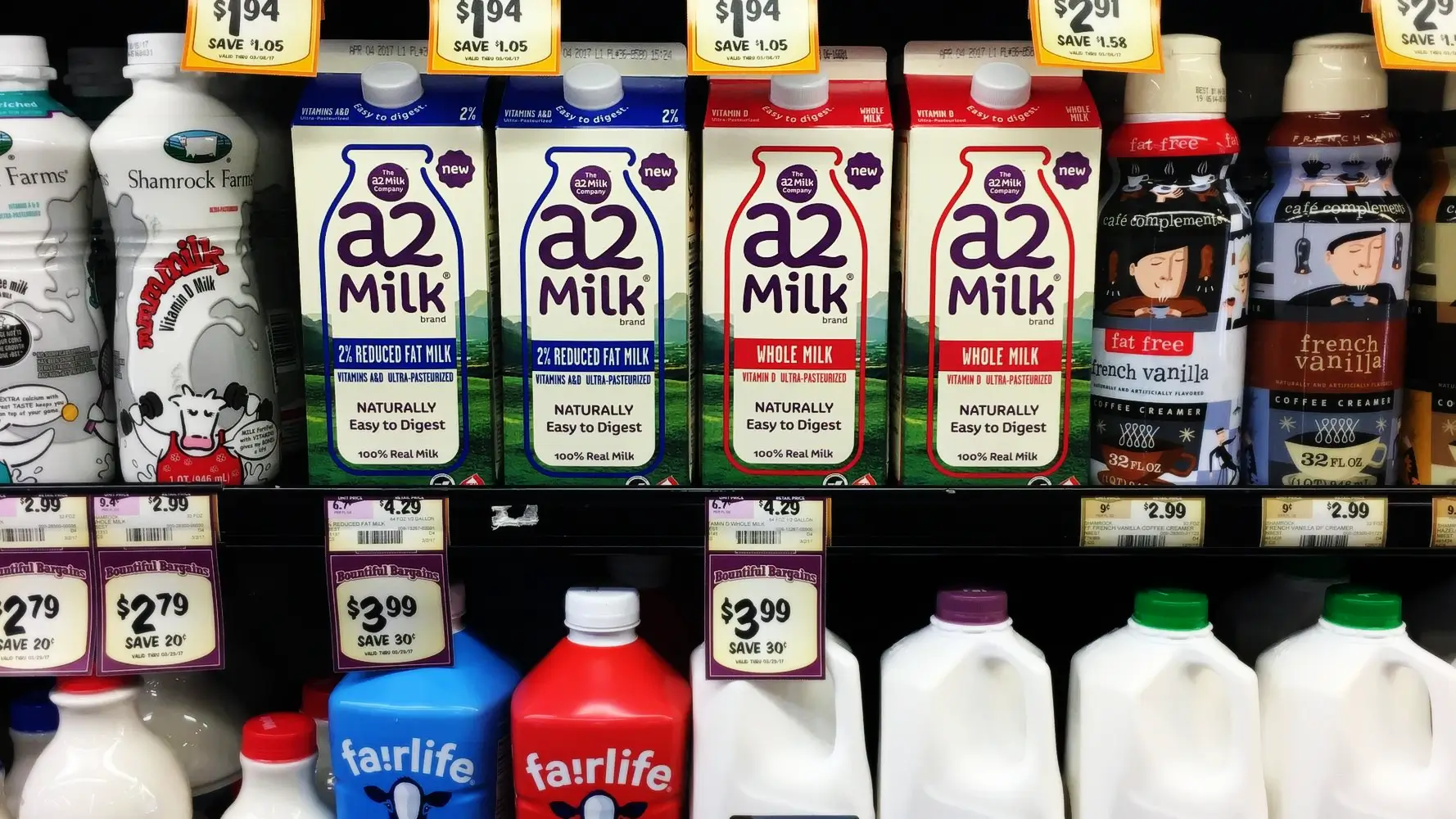Lactose intolerance- 65% chance you have it
People of European descent can drink milk and the rest of the globe has lactose intolerance. There are however substances in milk that none of us can tolerate.
Milos Pokimica
Written By: Milos Pokimica
Medically Reviewed by: Dr. Xiùying Wáng, M.D.
Updated May 7, 2023People of European descent can drink milk and the rest of the globe has lactose intolerance. Black Africans are 98 percent lactose intolerant and numbers for lactose intolerance in Asia are similar (Ugidos-Rodríguez et al.)[1].
Scientific research confirmed in different ancient European genome studies that the hunter-gatherers in Europe could not digest lactose in milk 8000 years ago. The first Europeans who domesticated wild animals were also unable to consume milk. The settlers who came from the Near East about 7800 years ago also had lactose intolerance. The Yamnaya pastoralists who came to Europe from the eastern steppes around 4800 years ago also had lactose intolerance.
It was not until about 2300 BC about 4300 years ago, in the early Bronze Age, that lactose tolerance swept through Europe (Gamba et al.)[2]. When we look at today’s world most of the population still can’t digest milk. If lactose-intolerant individuals consume lactose-containing products, they may experience bloating, nausea, abdominal pain, flatulence, and diarrhea.
Lactose is split down into a regular usable sugar by a specific enzyme called lactase created by cells in the wall lining of the small intestine (Storhaug et al.)[3]. Production of lactase is turned off in mammals in adulthood because mammals breastfeed only in the first periods after birth. Later in life in average conditions, it is not necessary to have this enzyme because no mammal will ever breastfeed again, except humans. Grown mammalian species do not breastfeed, and the organism is adapted to turn enzymes off to save energy. By domesticating wild animals and milking them, early farmers changed the condition of their habitat, and in time organisms adapted.
Today only descendants of European farmers can still digest milk. Black Africans cannot. Asians cannot. The statistic for lactose intolerance is like this. Approximately 65 percent of the entire human population has a reduced ability to digest lactose after infancy. In comparison, 5 percent of people of Northern European descent are lactose intolerant.
There are, however, a lot of substances in milk that we cannot tolerate. Even if we are from dairy queen countries we still can’t cope very well with things like cholesterol, a form of Lacto morphine called casomorphin, and estradiol (dairy consumption accounts for 60 to 80 percent of all estrogen consumed in the typical American diet). Opiates from the mother’s milk produce a sedative effect on the infant. That sedative effect is responsible for a good measure of the mother-infant bond. Milk has a drug-like effect on the baby (or other mammalian cubs), and it guarantees that the baby will bond with the mom and proceed to the nurse and get the nutrients. It is an evolutionarily beneficial adaptation. Similar to heroin or codeine, casomorphins slow intestinal movements and have an antidiarrheal effect. The opiate effect is the reason why cheese can be constipating just as opiate painkillers are.
Lactase is an enzyme that allows the organism to digest milk sugar, and that sugar is lactose. Danes are only 2% lactose intolerant.
All mammals after rejection from sucking are lactase deficient. They do not have contact with the milk later in life. The reactions of any organism that does not need to use the sugar lactose in adulthood are to deactivate the enzyme lactase so that the enzyme lactase is deactivated at the level of the genes. Except for the European farmers, which forced their bodies for thousands of years to consume it.
Thus, Danes today are only 2% non-tolerant, Finland 18%, Indians 50%, Israeli Jews 58%, African American 70%, Ashkenazi Jews 78%, Arabs 78%, Taiwanese 85%, Greek Cypriots 85%, Japanese 85%, Thailand 90%, Filipino 90%, Black African over 90% (Storhaug et al.)[3]. WHO has put that number up, saying that it is around 95% to 100%, for Indians 90 to 100, for Asians 90 to 95, for Mediterranean 60 to 75 and North American 10 to 15 and Europe 5 to 10 percent.
The real problem is that even if we are lactose tolerant lactose is metabolized in an unnatural way and is not meant to be consumed for an extended period of time. We have the enzyme lactase that breaks sugar lactose on dextrose and galactose. Half is glucose and the other half is galactose.
However, galactose cannot be used until it is digested in glucose. Cells only use glucose as fuel. There is an enzyme called beta-galactosidase that changes galactose into the glucose that we need. However, since no animal needs this enzyme after rejection, this enzyme is deactivated forever. Everyone, every human on the planet Earth if it is a grown individual has galactosidase deficiency. All of you who are reading this now and I have a deficiency of beta-galactosidase. This means that if you consume sugar from milk meaning lactose if you are lactose tolerant you can use it, you have lactase. Lactase metabolizes lactose and you will get glucose and besides it galactose. Glucose will be used normally. And with galactose, what are we going to do? We cannot use it so where does galactose go?
Some of it gets ejected outside through the skin. Some end up in the eyes and are stored in the cornea. Elderly cataracts come from galactose. Adults who consume large amounts of milk, and have high lactase activity, often suffer from galactose accumulation of galactitol in the eye lobe and have a high likelihood of elderly cataracts (Arola et al.)[4].
Not only that but it is also stored in the body in other places as well. Women are accumulating around the ovaries, and it is associated with cancer of the ovaries and infertility. One in four couples goes to infertility treatments in European countries. In African countries, where they do not use milk, they have no problems with infertility. It is unknown as a disease. In Daniel W. Cramer Harvard Medical School study (Mustafa et al.)[5] a link between the consumption of galactose and the increased risk of ovarian cancer was observed. Lactose-intolerant women are likely to consume less lactose. They concluded that: “This finding suggests that decreased lactose intake early in life may reduce ovarian cancer risk although further studies are needed to confirm this finding.” For Thai women, for example, who do not consume milk, there is no infertility at the level of statistical significance. In Thailand where 98% of adults are lactose intolerant, the average fertility among women aged 35-39 years was only 26% lower than the maximum rate for ages 25-29 years. In Australia and the UK, where lactose intolerance affects only 5% of adult people the fertility rates for 35-39 years old are full 82% below the maximum rate for 25-29 years.
Besides the risks of milk consumption in lactose-tolerant individuals can drink milk, what will happen when an individual that is not tolerant of lactose drinks milk? Sugar from milk will be undigested. It will cause lactose to be broken down by bacteria in the intestines. Bacteria will start to multiply, this increases osmotic pressure, fluid flows into the intestines, and the individual gets diarrhea.
After World War 2, the U.S. had a big stockpile of powdered milk that they had to dispose of somehow. Instead, they decided that because there is a “protein gap” they send that powdered milk to Africa as humanitarian aid. Many already malnourished children and babies got diarrhea from it. African countries that got milk powder sent as humanitarian aid experienced an increase in mortality, especially in small children who were already at the level of severe malnutrition.
References:
Passages selected from a book: Pokimica, Milos. Go Vegan? Review of Science Part 1. Kindle ed., Amazon, 2018.
- Ugidos-Rodríguez, Santiago, et al. “Lactose Malabsorption and Intolerance: A Review.” Food & Function, vol. 9, no. 8, Royal Society of Chemistry, Aug. 2018, pp. 4056–68. https://doi.org/10.1039/c8fo00555a.
- Gamba, Cristina et al. “Genome flux and stasis in a five millennium transect of European prehistory.” Nature communications vol. 5 5257. 21 Oct. 2014, doi:10.1038/ncomms6257
- Storhaug, Christian Løvold et al. “Country, regional, and global estimates for lactose malabsorption in adults: a systematic review and meta-analysis.” The lancet. Gastroenterology & hepatology vol. 2,10 (2017): 738-746. doi:10.1016/S2468-1253(17)30154-1
- Arola, H, and A Tamm. “Metabolism of lactose in the human body.” Scandinavian journal of gastroenterology. Supplement vol. 202 (1994): 21-5. doi:10.3109/00365529409091741
- Mustafa, Osama M., and Yassine J. Daoud. “Is Dietary Milk Intake Associated With Cataract Extraction History in Older Adults? An Analysis From the US Population.” Journal of Ophthalmology, vol. 2020, Hindawi Publishing Corporation, Feb. 2020, pp. 1–7. https://doi.org/10.1155/2020/2562875.
- Merritt, Melissa A et al. “Dairy foods and nutrients in relation to risk of ovarian cancer and major histological subtypes.” International journal of cancer vol. 132,5 (2013): 1114-24. doi:10.1002/ijc.27701
Do you have any questions about nutrition and health?
I would love to hear from you and answer them in my next post. I appreciate your input and opinion and I look forward to hearing from you soon. I also invite you to follow us on Facebook, Instagram, and Pinterest for more diet, nutrition, and health content. You can leave a comment there and connect with other health enthusiasts, share your tips and experiences, and get support and encouragement from our team and community.
I hope that this post was informative and enjoyable for you and that you are prepared to apply the insights you learned. If you found this post helpful, please share it with your friends and family who might also benefit from it. You never know who might need some guidance and support on their health journey.
– You Might Also Like –

Learn About Nutrition
Milos Pokimica is a doctor of natural medicine, clinical nutritionist, medical health and nutrition writer, and nutritional science advisor. Author of the book series Go Vegan? Review of Science, he also operates the natural health website GoVeganWay.com
Medical Disclaimer
GoVeganWay.com brings you reviews of the latest nutrition and health-related research. The information provided represents the personal opinion of the author and is not intended nor implied to be a substitute for professional medical advice, diagnosis, or treatment. The information provided is for informational purposes only and is not intended to serve as a substitute for the consultation, diagnosis, and/or medical treatment of a qualified physician or healthcare provider.NEVER DISREGARD PROFESSIONAL MEDICAL ADVICE OR DELAY SEEKING MEDICAL TREATMENT BECAUSE OF SOMETHING YOU HAVE READ ON OR ACCESSED THROUGH GoVeganWay.com
NEVER APPLY ANY LIFESTYLE CHANGES OR ANY CHANGES AT ALL AS A CONSEQUENCE OF SOMETHING YOU HAVE READ IN GoVeganWay.com BEFORE CONSULTING LICENCED MEDICAL PRACTITIONER.
In the event of a medical emergency, call a doctor or 911 immediately. GoVeganWay.com does not recommend or endorse any specific groups, organizations, tests, physicians, products, procedures, opinions, or other information that may be mentioned inside.
Editor Picks –
Milos Pokimica is a health and nutrition writer and nutritional science advisor. Author of the book series Go Vegan? Review of Science, he also operates the natural health website GoVeganWay.com
Latest Articles –
Top Health News — ScienceDaily
- Harvard gut discovery could change how we treat obesity and diabeteson December 14, 2025
Scientists found that certain molecules made by gut bacteria travel to the liver and help control how the body uses energy. These molecules change depending on diet, genetics, and shifts in the microbiome. Some even improved insulin response in liver cells when tested in the lab. The findings could open the door to new ways of preventing or managing obesity and diabetes.
- A grad student’s wild idea triggers a major aging breakthroughon December 14, 2025
Senescent “zombie” cells are linked to aging and multiple diseases, but spotting them in living tissue has been notoriously difficult. Researchers at Mayo Clinic have now taken an inventive leap by using aptamers—tiny, shape-shifting DNA molecules—to selectively tag these elusive cells. The project began as an offbeat conversation between two graduate students and quickly evolved into a collaborative, cross-lab effort that uncovered aptamers capable of binding to unique surface proteins […]
- Natural compound supercharges treatment for aggressive leukemiaon December 14, 2025
Forskolin, a plant-derived compound, shows surprising potential against one of the most aggressive forms of leukemia. Researchers discovered that it not only stops cancer cells from growing but also makes them far more vulnerable to chemotherapy by preventing them from pumping out the drugs meant to kill them. Experts say this dual action could help create safer, more powerful AML treatments with fewer harsh side effects.
- AI finds a hidden stress signal inside routine CT scanson December 14, 2025
Researchers used a deep learning AI model to uncover the first imaging-based biomarker of chronic stress by measuring adrenal gland volume on routine CT scans. This new metric, the Adrenal Volume Index, correlates strongly with cortisol levels, allostatic load, perceived stress, and even long-term cardiovascular outcomes, including heart failure risk.
- Tea may strengthen bones in older women while heavy coffee weakens themon December 13, 2025
A decade-long study of older women found that tea drinkers had slightly stronger bones, while moderate coffee drinking caused no harm. Heavy coffee intake—over five cups a day—was linked to lower bone density, especially in women who consumed more alcohol. Tea’s benefits may stem from catechins that support bone formation. The researchers say small daily habits could make a meaningful difference over time.
- The brain switch that could rewrite how we treat mental illnesson December 13, 2025
Scientists exploring how the brain responds to stress discovered molecular changes that can influence behavior long after an experience ends. They also identified natural resilience systems that help protect certain individuals from harm. These findings are opening the door to treatments that focus on building strength, not just correcting problems. The work is also fueling a broader effort to keep science open, independent, and accessible.
- Ozempic may offer a surprising bonus benefit for brain healthon December 13, 2025
A new analysis suggests that people with type 2 diabetes who use GLP-1 medications like Ozempic, Trulicity or Victoza may be less likely to develop epilepsy than those taking DPP-4 inhibitors. Semaglutide showed the strongest connection to lowered risk. Researchers caution that the findings show an association, not proof of cause and effect. More rigorous long-term studies are needed to understand the link.
PubMed, #vegan-diet –
- Healthful and Unhealthful Plant-Based Diets and Their Association with Cardiometabolic Targets in Women Diagnosed with Breast Cancer: A Cross-Sectional Analysis of a Lifestyle Trialon December 11, 2025
CONCLUSIONS: Maintaining cardiometabolic risk factors within normal ranges is clinically relevant in BCS, and this may be more likely when a plant-based diet is consumed, especially if low in unhealthy plant foods.
- Dietary and Lifestyle Patterns and Their Associations with Cardiovascular and Inflammatory Biomarkers in Vegans, Vegetarians, Pescatarians, and Omnivores: A Cross-Sectional Studyon December 11, 2025
Background: Plant-based diets are associated with reduced cardiometabolic risk, yet the influence of lifestyle behaviors on these benefits remains insufficiently understood. Objective: To assess the combined impact of dietary patterns and lifestyle behaviors on body composition, lipid profiles, and inflammatory biomarkers in healthy young adults. Methods: In this cross-sectional study, 155 participants aged 18-39 years were categorized into four dietary groups: vegans (n = 48), vegetarians (n […]
- Functional and Nutritional Properties of Lion’s Mane Mushrooms in Oat-Based Desserts for Dysphagia and Healthy Ageingon December 11, 2025
Hericium erinaceus (Lion’s Mane mushroom) is a medicinal species recognised for its neuroprotective and antioxidant properties. This study investigated its potential as a functional ingredient in oat milk-based desserts formulated for individuals with dysphagia. Freeze-dried Lion’s Mane powder (LMP), containing high-quality protein (~16%, amino acid score 88%), dietary fibre (~31%), and phenolic compounds (72.15 mg GAE/g), was incorporated at varying levels using gelatin or iota-carrageenan […]
- “A football team with no midfield”: A qualitative analysis of anti-vegan stigma in Italyon December 7, 2025
A growing body of research has demonstrated the prevalence of unfavourable attitudes towards individuals who adhere to a vegan diet and has provided empirical evidence to support the existence of an anti-vegan ideology. The present study aims to contribute to extant knowledge by examining the social perception of veganism and vegans in Italy. Italy is a nation characterised by a traditional culture of food that serves as a significant catalyst for collective identification and national pride….
- Plant-based dietary index on the Mediterranean and a vegan diet: a secondary analysis of a randomized, cross-over trialon December 5, 2025
CONCLUSION: These findings suggest that, replacing animal products even with the “unhealthful” plant-based foods on a vegan diet was associated with weight loss.
Random Posts –
Featured Posts –
Latest from PubMed, #plant-based diet –
- Identification of effective plant-based oils for use in aquafeed: An evaluation of impact on gamete quality and developmental success using zebrafish (Danio rerio) as a screening organismby Seyed-Mohammadreza Samaee on December 14, 2025
To evaluate the effectiveness of zebrafish as a screening system for identifying appropriate plant oils (POs) for aquafeed, Artemia nauplii (AN) were enriched with three single- cultivar olive oils (OO): Koroneiki, Parseh, and Arghavan. The resulting AN (ANKor, ANPar, ANArg, and AN36 [36 h starved AN, control]) were then fed to 360 fish (3.5 cm) for one month. The fatty acid (FA) profile of the AN was reflected in the ova and influenced both sperm motility and density, which in turn affected […]
- The Effect of Dietary Interventions on Human Vascular Function in the Context of Acute Psychological Stress: A Scoping Reviewby Rosalind Baynham on December 14, 2025
Episodes of acute psychological stress increase the risk for cardiovascular diseases, partially through stress-induced impairments in vascular function. During psychologically stressful periods, individuals are more likely to consume unhealthy foods and fewer fruits and vegetables. Yet, the impact of dietary choices and their nutritional composition on vascular function in the context of psychological stress is unclear. In this scoping review, comprehensive database searches were carried out […]
- The effect of a diet based on vegetable and dairy protein on biochemical and functional indicators of sarcopenia in patients with liver cirrhosis: a randomized controlled trialby Mahdiyeh Taghizadeh on December 13, 2025
CONCLUSIONS: In conclusion, a vegetable and dairy protein-based diet effectively inhibited significant elevations in ammonia levels compared to the standard diet in persons with liver cirrhosis; however, anthropometric parameters and muscle function did not differ between two groups.
- Gut microbiota and nutritional interventions in alcohol-associated liver disease: Mechanisms and therapeutic advancesby Ashi Mittal on December 13, 2025
Alcohol-associated liver disease (ALD) is a leading cause of liver-related morbidity and mortality worldwide. Despite growing awareness of its burden, treatment options remain limited, with abstinence as the only widely accepted intervention. Recent research underscores the critical role of the gut-liver axis and nutritional status, particularly dietary protein, in modulating ALD pathogenesis and progression. This review aims to integrate current knowledge on the interplay between gut…
- Effects of an anti-lipogenic low-carbohydrate high polyunsaturated fat diet or a healthy Nordic diet versus usual care on liver fat and cardiometabolic disorders in type 2 diabetes or prediabetes: a…by Michael Fridén on December 13, 2025
Polyunsaturated fatty acids (PUFA) have been shown to reduce liver fat compared to saturated fat, but effects of a novel “anti-lipogenic” diet replacing carbohydrates with PUFA (LCPUFA) or a low-fat healthy Nordic diet (HND) rich in whole-grains are unknown. The objective of this study was to investigate the effects of these diets, as compared with usual care (UC), on liver fat (primary outcome) and related glycemic and lipid disorders after 12 months of intervention, in individuals with…
- Triumphing over hidden hunger: Redesigning rice (Oryza sativa L.) for enhanced nutraceutical grain composition utilizing multiplexed genome editingby Khaled Fathy on December 12, 2025
Rice, a staple food crop, is consumed by most of the world’s population. Micronutrient malnutrition is a severe health issue, leading to diseases such as cancer, anemia, diabetes, heart disease, and disorders in physical and psychological development. We aimed to create rice with low cadmium in the grain but having high cadmium in shoots, safe biofortified protein, high iron, and zinc using CRISPR/Cas9 and breeding technologies instead of adding drugs. The triple gene Knockout rice lines for […]












